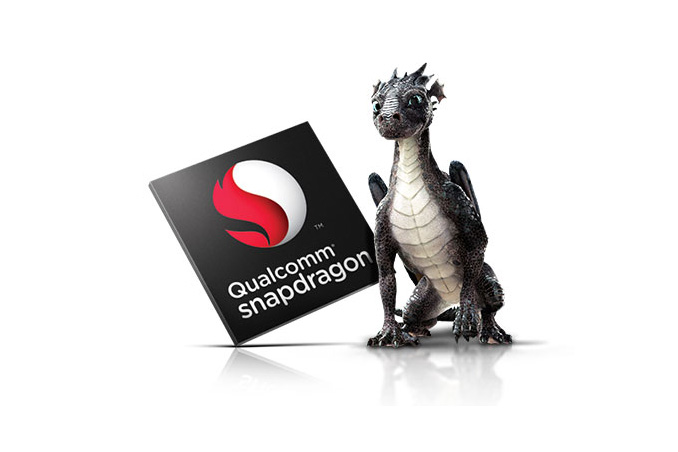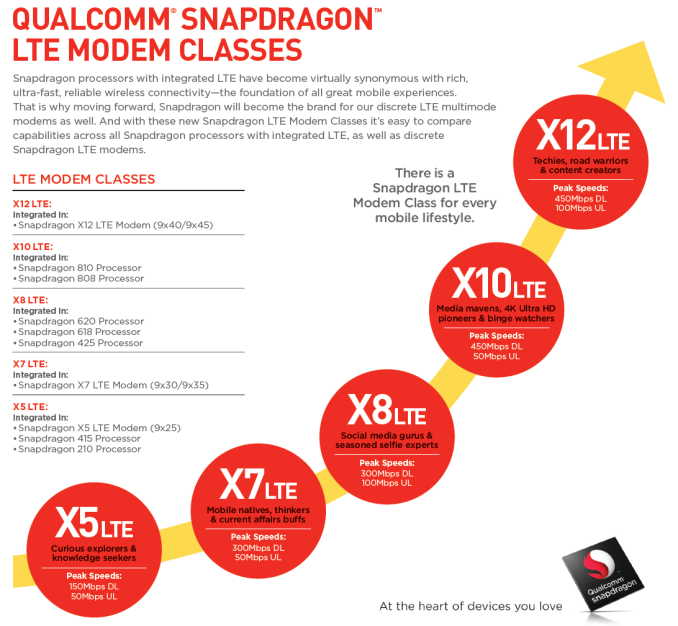Qualcomm Announces New SoC Lineup, Modem Branding
by Andrei Frumusanu on February 18, 2015 8:47 AM EST
Qualcomm today announced 4 new additions to its Snapdragon 400 and 600 lineup of SoCs, along with a reshuffle and rebranding of their modem lineup. Let's begin with the new SoC offerings:
The Snapdragon 415 and 425 are additions to the low-end of Qualcomm's SoC offerings. The Snapdragon 415 is described a "quick transition piece" to the Snapdragon 410 which we suspect means it will be a pin-compatible SoC upgrade. It doubles up on the core-count from 4 A53 processors up to 8. The cores are still clocked in at the same 1.4GHz frequency. On the GPU side we see an upgrade from the Adreno 306 to a newer Adreno 405 and memory speeds have been slightly bumped from 533MHz to 667MHz LPDDR3, dropping LPDDR2 capability from the SKU.
| Qualcomm Snapdragon 400 Lineup | |||
| SoC | Snapdragon 410 | Snapdragon 415 | Snapdragon 425 |
| CPU | 4x Cortex A53@1.4GHz | 4x Cortex A53@?GHz 4x Cortex A53@1.4GHz |
4x Cortex A53@?GHz 4x Cortex A53@1.7GHz |
| Memory Controller |
1x 32-bit @ 533MHz LPDDR2/3 4.2GB/s b/w |
1x 32-bit @ 667MHz LPDDR3 5.3GB/s b/w |
1x 32-bit @ 933MHz LPDDR3 7.5GB/s b/w |
| GPU | Adreno 306 | Adreno 405 | Adreno 405 |
| Encode/ Decode |
1080p H.264 | 1080p H.264 1080p30 HEVC decode |
1080p H.264 1080p30 HEVC decode |
| Camera/ISP | 13.5MP | 13MP | Dual ISP 21MP |
| Integrated Modem |
Cat. 4 150Mbps | "X5 LTE" Cat. 4 150Mbps DL 50Mbps UL |
"X8 LTE" Cat. 7 300Mbps DL 100Mbps UL 2x20MHz C.A. (DL & UL) |
The Snapdragon 425 is also a octa-core A53 unit with the same GPU implementation, but clocked at a slightly higher 1.7GHz on the one of the A53 clusters. It's on the integrated modem side where things change, as the S425 employs a new integrated "X8 LTE" Category 7 LTE modem versus the Category 4 one found in the S415. The new unit also brings down the dual-ISP feature from the higher-end SoCs to the entry-level, enabling dual cameras up to 21MP. This should be an interesting SoC in the entry range as the specifications in terms of performance seem to match the Snapdragon 615 of the mid-range series.
While the entry range gets some large performance and connectivity boosts, today's biggest news comes in form of the Snapdragon 618 and 620. These are the first announced Cortex A72 SoCs, ARM's new high-end CPU architecture which was publicly announced just two weeks ago.
| Qualcomm Snapdragon 600 Lineup | ||||
| SoC | Snapdragon 610 | Snapdragon 615 | Snapdragon 618 | Snapdragon 620 |
| CPU | 4x Cortex A53@1.7GHz | 4x Cortex A53 @1.0GHz 4x Cortex A53 @1.7GHz |
4x Cortex A53 @1.2GHz 2x Cortex A72 @1.8GHz |
4x Cortex A53 @1.2GHz 4x Cortex A72 @1.8GHz |
| Memory Controller |
1x 32-bit @ 800MHz LPDDR3 6.4GB/s b/w |
1x 32-bit @ 800MHz LPDDR3 6.4GB/s b/w |
2x 32-bit @ 933MHz LPDDR3 14.9GB/s b/w |
2x 32-bit @ 933MHz LPDDR3 14.9GB/s b/w |
| GPU | Adreno 405 | Adreno 405 | "Next-gen" Adreno | "Next-gen" Adreno |
| Encode/ Decode |
1080p H.264 1080p30 HEVC decode |
1080p H.264 1080p30 HEVC decode |
2160p30, 1080p120 H.264 & HEVC |
2160p30, 1080p120 H.264 & HEVC |
| Camera/ISP | 21MP | 13MP | Dual ISP 21MP |
Dual ISP 21MP |
| Integrated Modem |
Cat. 4 150Mbps DL 50Mbps UL |
"X5 LTE" Cat. 4 150Mbps DL 50Mbps UL |
"X8 LTE" Cat. 7 300Mbps DL 100Mbps UL 2x20MHz C.A. (DL & UL) |
"X8 LTE" Cat. 7 300Mbps DL 100Mbps UL 2x20MHz C.A. (DL & UL) |
The Snapdragon 618 and 620 bring dual-channel memory back into the mid-range, employing LPDDR3 targeted at 933MHz, making them on par with today's Snapdragon 800 and 801 SoCs. The new offerings now employ full HEVC (H.265) hardware encoding and decoding, a feature first seen in the Snapdragon 810. Similarly to the 425, the usually high-end dual ISP functionality is brought down into the new SKUs and offer up to 21MP camera sensor functionality.
What Qualcomm doesn't specify though, is the GPU. We're being promised a new "next-generation" Adreno GPU, so we might be talking about a new 500-series, but we don't know for sure until Qualcomm actually announces the new architecture.
The Snapdragon 618 and 620 employ Qualcomm's new "X8" integrated modem solutions, capable of Category 7 LTE with up to 300Mbps downstream or 100Mbps upstream via 2x20MHz carrier aggregation on either upload or download channels.
Getting back to the CPU configuration: The Cortex A72 replaces the use of a higher-clocked A53 cluster as the "big" part of these new big.LITTLE SoCs. The A72 was announced as ARM's new flagship high-end core, so it's very interesting to see Qualcomm employ it in a mid-range SoC at only 1.8GHz. It would look like these new units are still manufactured under 28nm given the clock speeds. We still don't know much about the A72 core, but ARM's Peter Greenhalgh clarified that we should be seeing a 10-50% IPC gain over the A57 while improving power on the same process node and libraries. To see Qualcomm use the A72 in a mid-range SoC begs the question of exactly how big these new cores are, as pricing is be an important competitive factor below the high-end.
Qualcomm expects the Snapdragon 415, 425, 618 and 620 to ship in consumer devices in the latter half of 2015. This is an interesting timeline as the 618 and 620 pose direct competition to the Snapdragon 808 which we still haven't seen announced in any consumer device. On the high-end, Qualcomm is still keeping very quiet as we still don't know what the successor to the Snapdragon 810 will look like or what the state of Qualcomm's new ARMv8 core is in.
Modem re-branding
Finally as part of today's announcement, is a re-branding of Qualcomm's modem line-up. The "Gobi" name is abandoned in favour of a "X# LTE" denomination. It's to be noted that the model numbers don't correspond to actual LTE category capability, as for example the X10 and X12 modems are capable of respectively Category 9 and 10 LTE. The aforementioned parts are re-brandings of the modem variants which we find in the standalone Gobi 9x45 and 9x40 and Snapdragon 808 and 810 SoCs.
Today Qualcomm raised the bar for low- and mid-range SoCs and we're looking forward to what kind devices Qualcomm's OEM partners will come up with towards the end of the year.











40 Comments
View All Comments
yankeeDDL - Wednesday, February 18, 2015 - link
Sounds like Qualcomm is feeling the pressure of MediaTek on mid/low range. Cellphones with the 6** series should be quite interesting from a price/performance perspective.Mondozai - Wednesday, February 18, 2015 - link
The big question mark is the high-end. TSMC's endless delays means we're unlikely to see 16 nm FinFET this year despite all their hype. Samsung are the only ones beside Intel on 14 now, and they are trying to steal Qualcomm's lunch at the high-end, so they won't give access to fabs. GloFo could but they are behind a few quarters.Qualcomm's Krait ARMv8 is now shrouded in mystery. Will we even see it this year? I mean Qualcomm must be hoping so, because the midrange S620 basically nullifies the S810.
The whole point of the S810 was to use ARM's stuff in order to gain time, but are we now going to see a repeat with the A72 where the high-end will be made on a lower node and that alone?
yankeeDDL - Wednesday, February 18, 2015 - link
There's little competition on the high end and the 810 is not very exciting, frankly. Qualcomm might have misstepped here in favor of the new Exynos, but the high end has limited volumes as the prices are still astronomical. The volume is in the mid range. Hopefully the time for the shitty 1GB, single-core, slow-as-hell Android phones is over and even the entry level could be decent phones. If the 620 has performance comparable to the 800, that makes it a top-notch processor for a mid range phone. Maybe we can see a series of phones with a price/performance ratio comparable to the Nexus 5, which is still an excellent phone, but with an improvable battery and camera.rahul1200 - Wednesday, February 18, 2015 - link
Next announcement in line is probably Snapdragon 815 and 820 which will be the flagship chipset in entire market.Refer: http://www.stjsgadgets-portal.com/2015/02/things-y...
Frenetic Pony - Wednesday, February 18, 2015 - link
Samsung's "14nm" is PR bull, it's the 20nm process they have now transferred to Finfet, meaning it's a nigh equivalent process to Intel's 22nm finfet, just like TSMC's upcoming "16nm" process is.Of course the "process size" hasn't really been a good description of actual feature size for some time, so TSMC and Samsung feel free to just call their newer processes whatever they want without any connection to reality. TSMC claims it will have a "10nm" process in 2017, but by actual silicon density it will really be equivalent to Intel's "14nm" process.
yankeeDDL - Thursday, February 19, 2015 - link
Intel's process is optimized for regular layout so they have an advantage. As foundries, TSMC and Samsung need to leave more flexibility to their customers and be less restrictive in terms of uniformity requirements and this forces them to design rules that are less dense. This has always been the case: it's only exacerbated by the smaller nodes.In the end, it really depends what your focus is. From a pure density perspective, yes, you're completely right. From a speed vs power consumption perspective, however, it'snot so easy. Imagine what AMD's chips would consume using 16nm node instead of 28nm (~4x scaling in gate area), just to make an example.
In mobile, I'd argue that power consumption (vs speed) is key, therefore Samsung's (and TSMC) offering, seems to me to be quite relevant.
patrickjp93 - Sunday, February 22, 2015 - link
Even Samsung isn't on 14nm FF. It's only marketing. Their 14nm FF process is less dense than their 20nm planar! https://www.semiwiki.com/forum/content/3884-who-wi...levizx - Monday, February 23, 2015 - link
Ya, posting the same sh*t over and over again is really intuitive. The same data shows Intel's 22nm is barely better than GF's 32/28nm, 32nm barely better than 45nm, 45nm worse than 65nm. So who's the phony one now?dragonsqrrl - Wednesday, February 18, 2015 - link
Ya, apparently Samsung's 14nm finFET is not equivalent to Intel's 14nm process. And although Samsung's 14nm is now production ready, there are still no products on the market (it takes time to ramp up production), whereas Intel has been shipping 14nm processors for the past 6 months. Intel is still quite far ahead.dragonsqrrl - Wednesday, February 18, 2015 - link
Sorry, somehow I managed to respond to the wrong comment. Intended to respond to Mondozai.